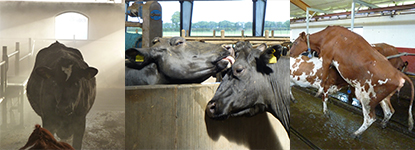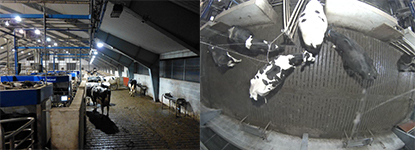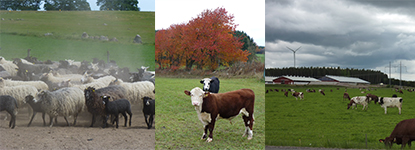Animal Environment and Building Function

The subject area includes research, collaboration, and teaching about the impact of technology and housing environment in different management systems for livestock production with special emphasize on animal welfare but also with our environment in mind.
Our goal is to remain at the forefront in the development of a future, and from all aspects, sustainable and safe animal production where our expertise covers design and technology in the stall which interact with animals, people and natural resources.
We develop, investigate and mediate how new technology in facilities for livestock production works in a practical context. We define what is required to take and idea to practical use and thus contribute to the basis for the application of the technology.
Scientists ' expertise includes ethology, animal science, technology/engineering, veterinary medicine, and often in cooperation with subject areas: architecture, work science, economics, mathematics, computer science, statistics, etc.
Focus areas:
Stall function and comfort: Animal welfare, animal behavior, animal health

The housing facilities and their function are of the utmost importance for the health and welfare of animals. Especially in stables for livestock production where many animals live together in a restricted space, many times a tough environment can threaten the hierarchy, causing injuries and culling of weaker animals. Our research aim to optimize each functional area of the stable such as where the animals are walking, standing, lying, resting,feeding and being milked. An optimized function means, among other things, that the floor where the animals walk and stand should be soft and non-slip while it should wear the claws somewhat and promote mobility. The lying area shall comfortable and able to be kept clean in a rational manner and shall not cause traumatic injuries. The house should be large enough that the animal can behave normally with good cow traffic. It should be designed and equipped with facilities to keep a good hygiene and reduce risks for traumatic injuries.
Surveillance: Precision Livestock Farming, PLF

To keep in pace with increasing demands on profitability and sustainable production, a rapid rationalization of labor is evident in animal husbandry. More animals should be managed by fewer people and we'll be relied more and more on automated systems to measure the consumption, production and function. We replace the human animal eye with cameras and calculate deviations with algorithms. This surveillance and automatization in animal production is called Precision Livestock Farming (PLS). Although a good eye for animal management is difficult to replace, our group tries to remain at the forefront of the development of systems for monitoring animal welfare and health automatically.
Ongoing projects about Surveillance: Precision Livestock Farming, PLF
Environment: Environmentally sustainable husbandry

Confinement of animals on a smaller surface area in the stables and concentration to regions with greater animal production not only increases the risk of disturbance of the animals themselves but also on the inside and outdoor environment. All feed will be digested in the animals and become not only foods, but also resulting in byproducts in the form of manure and environmental gases. The aim of our research is to optimize feeding from a holistic perpective. This means to have an efficient usage of feed and to recycle the nutrients and reducing losses (gas emissions) that could pose an environmental problem and affect our climate. By developing systems that reduces or minimizes gas emissions as well as to take advantage of the fertilizer efficiently we can make use of resources and reduce harmful impacts on the environment.
Ongoing projects about Environment: Environmentally sustainable husbandry
Research Projects:
Ongoing
Ongoing projects about Stall function and comfort: Animal welfare, animal behavior, animal health
Ongoing projects about Surveillance: Precision Livestock Farming, PLF
Ongoing projects about Environment: Environmentally sustainable husbandry
Closed
Animal Environment and Building Function
Contact
Responsible for the subject area Hanna Sassner
Malin Axel-Nilsson
Rebecca Grut - Project SmellThis
Oleksiy Guzhva
Knut-Håkan Jeppsson
Elin Karlsson
Anna Lindqvist
Madeleine Magnusson
Heta Rautiainen - Project SmellThis
Maria Vilain Rørvang
Laurence Smith
Johanna Stenfelt
Evgenij Telezhenko
Rebecka Westin
Jenny Yngvesson
Frida Åkerström